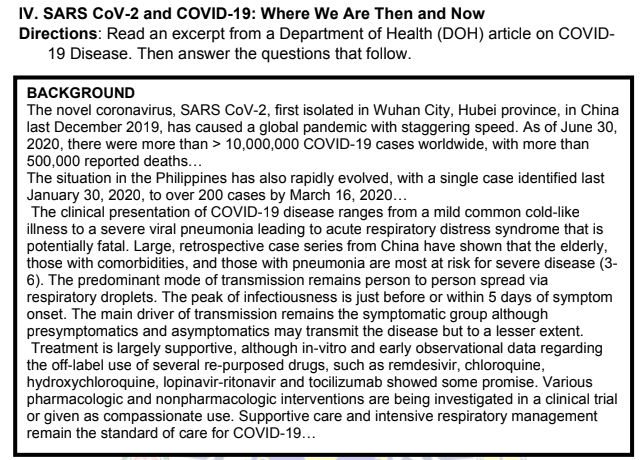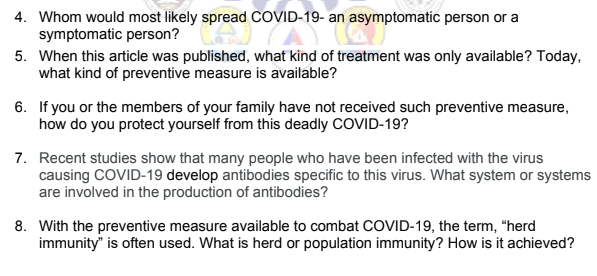Biomedical Instrumentation Systems
1st Edition
ISBN:9781133478294
Author:Chatterjee
Publisher:Chatterjee
Chapter17: Instrumentation In Intensive Care Units
Section: Chapter Questions
Problem 1RT
Related questions
Question
please do answer all of the question, thank you! :>

Transcribed Image Text:IV. SARS COV-2 and COVID-19: Where We Are Then and Now
Directions: Read an excerpt from a Department of Health (DOH) article on COVID-
19 Disease. Then answer the questions that follow.
BACKGROUND
The novel coronavirus, SARS COV-2, first isolated in Wuhan City, Hubei province, in China
last December 2019, has caused a global pandemic with staggering speed. As of June 30,
2020, there were more than > 10,000,000 COVID-19 cases worldwide, with more than
500,000 reported deaths...
The situation in the Philippines has also rapidly evolved, with a single case identified last
January 30, 2020, to over 200 cases by March 16, 2020...
The clinical presentation of COVID-19 disease ranges from a mild common cold-like
illness to a severe viral pneumonia leading to acute respiratory distress syndrome that is
potentially fatal. Large, retrospective case series from China have shown that the elderly,
those with comorbidities, and those with pneumonia are most at risk for severe disease (3-
6). The predominant mode of transmission remains person to person spread via
respiratory droplets. The peak of infectiousness is just before or within 5 days of symptom
onset. The main driver of transmission remains the symptomatic group although
presymptomatics and asymptomatics may transmit the disease but to a lesser extent.
Treatment is largely supportive, although in-vitro and early observational data regarding
the off-label use of several re-purposed drugs, such as remdesivir, chloroquine,
hydroxychloroquine, lopinavir-ritonavir and tocilizumab showed some promise. Various
pharmacologic and nonpharmacologic interventions are being investigated in a clinical trial
or given as compassionate use. Supportive care and intensive respiratory management
remain the standard of care for COVID-19...

Transcribed Image Text:4. Whom would most likely spread COVID-19- an
an
symptomatic person?VID-19-an asy
asymptomatic person or a
asympt
5. When this article was published, what kind of treatment was only available? Today,
what kind of preventive measure is available?
6. If you or the members of your family have not received such preventive measure,
how do you protect yourself from this deadly COVID-19?
7. Recent studies show that many people who have been infected with the virus
causing COVID-19 develop antibodies specific to this virus. What system or systems
are involved in the production of antibodies?
8. With the preventive measure available to combat COVID-19, the term, "herd
immunity" is often used. What is herd or population immunity? How is it achieved?
Expert Solution
This question has been solved!
Explore an expertly crafted, step-by-step solution for a thorough understanding of key concepts.
Step by step
Solved in 2 steps

Knowledge Booster
Learn more about
Need a deep-dive on the concept behind this application? Look no further. Learn more about this topic, biology and related others by exploring similar questions and additional content below.Recommended textbooks for you


Human Biology (MindTap Course List)
Biology
ISBN:
9781305112100
Author:
Cecie Starr, Beverly McMillan
Publisher:
Cengage Learning


Human Biology (MindTap Course List)
Biology
ISBN:
9781305112100
Author:
Cecie Starr, Beverly McMillan
Publisher:
Cengage Learning